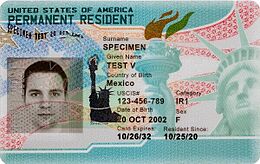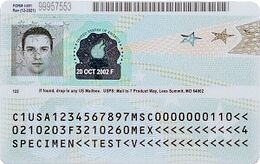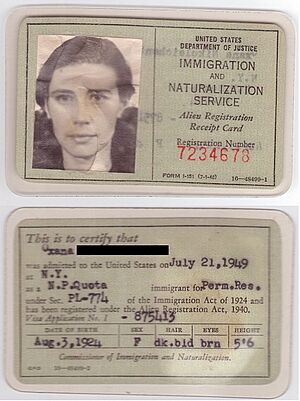Green card facts for kids
Quick facts for kids United States Permanent Resident ID Card |
|
|---|---|
 |
|

Sample of a Permanent Resident Card (often called a "green card") of the United States (2023)
|
|
| Type | Personal identification document |
| Issued by | |
| Purpose | Identification |
| Expiration | 10 years (standard) 2 years (conditional) |
A green card, officially known as a permanent resident card, is a special identity document in the United States. It shows that a person has permission to live and work permanently in the U.S. People who hold a green card are called lawful permanent residents (LPRs).
As of 2023, about 12.7 million people have green cards. Around 9 million of them can apply to become U.S. citizens. About 18,700 green card holders even serve in the U.S. Armed Forces.
Green card holders can apply to become U.S. citizens after living in the United States for a certain time. This is usually between one and five years. They also need to show they are good people. Children under 18 can automatically become U.S. citizens if they have at least one U.S. citizen parent.
The card is called a "green card" because it used to be green. It was once known as a "certificate of alien registration." Or an "alien registration receipt card." Immigrants 18 or older should always carry their green cards. If they don't, they could face penalties.
The United States Citizenship and Immigration Services (USCIS) usually decides green card applications. Sometimes, an immigration judge can grant permanent residency. This can happen during certain legal processes. People who want a green card for work can apply using a special form called I-140.
A lawful permanent resident could lose their green card. This can happen if they break serious rules or commit certain offenses. If this happens, they might have to leave the United States.
Contents
History of the Green Card

The Immigration and Naturalization Service (INS) started in 1933. It was first part of the Department of Labor. In 1940, it moved to the Department of Justice. This was when the Nationality Act of 1940 was passed.
During the 1940s, the green card was called the "Alien Registration Receipt Card." It had "Perm.Res" on the back. This stood for "Permanent Resident." It followed the rules of the Immigration Act of 1924.
The Immigration and Nationality Act (INA) was passed in 1952. It says that an "alien" is anyone who is not a citizen of the United States.
Green Card Lottery
Each year, about 55,000 immigrant visas are available. This is through the Diversity Visa (DV) program. It is also known as the Green Card Lottery. This lottery is for people born in countries with low rates of immigration to the United States. This means fewer than 50,000 immigrants in the last five years.
Applicants qualify based on their birth country. Not their citizenship. If someone wins the lottery, they can apply for permanent residence. They can also apply for their spouse and unmarried children under 21.
If permanent residence is approved, the winner gets an immigrant visa. This visa is placed in their passport. They must use it to enter the U.S. within six months. Once they enter, they get a stamp. This stamp proves they can live and work permanently in the U.S. The actual "green card" usually arrives by mail later.
Green Card Lottery Scams
There are many fake green card lottery scams. Some people pretend to be agents. They take money from applicants. They promise to submit application forms for them. Many of these agents do not work for official services.
Some scammers claim they can help you win the lottery. But they might delay your application. Or not submit it at all. Others promise free airline tickets or cash if you win. They might also promise future submissions. There is no way to guarantee these claims. These promises are often not true.
It is very important to use only official U.S. government websites. These websites always have a URL that ends in "`.gov`".
Green Card Lottery Email Fraud
Other scammers send fake emails. They pretend to be from the State Department or other government offices. They ask people to send money online. They say it is for a "processing fee." These emails are designed to steal money.
The senders use fake email addresses and logos. They try to look like official government mail. An easy way to spot a fake email is if it does not end with "`.gov`". For example, some fake emails ask you to send money via Western Union. They might ask you to send it to an address in London.
The USCIS blog has shared information about these email scams. They also explain how to report them. The U.S. government has warned people about these types of scams. Always be careful about emails asking for money.
See also
 In Spanish: Green Card para niños
In Spanish: Green Card para niños

